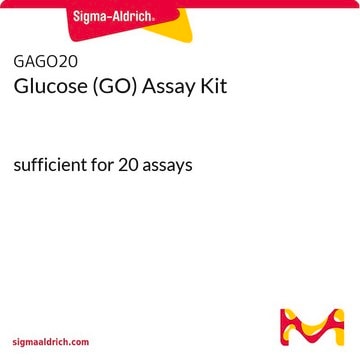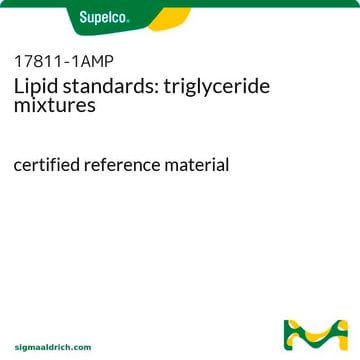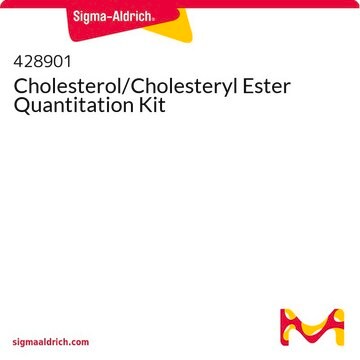Products may be shipped at a different temperature than the recommended long-term storage temperature. If the product quality is sensitive to short-term exposure to conditions other than the recommended long-term storage, it will be shipped on wet or dry-ice. If the product quality is NOT affected by short-term exposure to conditions other than the recommended long-term storage, it will be shipped at ambient temperature. As shipping routes are configured for minimum transit times, shipping at ambient temperature helps control shipping costs for our customers. For more information, please refer to the Storage and Transport Conditions document: https://www.sigmaaldrich.com/deepweb/assets/sigmaaldrich/marketing/global/documents/316/622/storage-transport-conditions-mk.pdf
MAK266
Triglyceride Quantification Colorimetric/Fluorometric Kit
sufficient for 100 colorimetric or fluorometric tests
Sinónimos:
TG Quantification Kit
Seleccione un Tamaño
Seleccione un Tamaño
About This Item
Productos recomendados
método de detección
colorimetric
fluorometric
enfermedades relevantes
neurological disorders; cardiovascular diseases
temp. de almacenamiento
−20°C
Descripción general
Idoneidad
Principio
Palabra de señalización
Danger
Frases de peligro
Consejos de prudencia
Clasificaciones de peligro
Resp. Sens. 1 - Skin Sens. 1
Código de clase de almacenamiento
10 - Combustible liquids
Punto de inflamabilidad (°F)
188.6 °F - closed cup
Punto de inflamabilidad (°C)
87 °C - closed cup
Elija entre una de las versiones más recientes:
Certificados de análisis (COA)
¿No ve la versión correcta?
Si necesita una versión concreta, puede buscar un certificado específico por el número de lote.
¿Ya tiene este producto?
Encuentre la documentación para los productos que ha comprado recientemente en la Biblioteca de documentos.
Los clientes también vieron
-
How is shipping temperature determined? And how is it related to the product storage temperature?
1 answer-
Helpful?
-
-
How can I determine the shelf life / expiration / retest date of this product?
1 answer-
If this product has an expiration or retest date, it will be shown on the Certificate of Analysis (COA, CofA). If there is no retest or expiration date listed on the product's COA, we do not have suitable stability data to determine a shelf life. For these products, the only date on the COA will be the release date; a retest, expiration, or use-by-date will not be displayed.
For all products, we recommend handling per defined conditions as printed in our product literature and website product descriptions. We recommend that products should be routinely inspected by customers to ensure they perform as expected.
For products without retest or expiration dates, our standard warranty of 1 year from the date of shipment is applicable.
For more information, please refer to the Product Dating Information document: https://www.sigmaaldrich.com/deepweb/assets/sigmaaldrich/marketing/global/documents/449/386/product-dating-information-mk.pdfHelpful?
-
-
Can ethanol or isopropanol (IPA) be used instead of water for liver tissue sample preparation with the Triglyceride Quantification Colorimetric/Fluorometric Kit (MAK266)?
1 answer-
Based on the guidelines, only water is an appropriate solvent for samples in this assay. Ethanol and isopropanol are not suitable solvents for this assay.
Helpful?
-
-
Is liver tissue extracted using RIPA buffer and without NP-40 compatible with the MAK266 Triglyceride Quantification Colorimetric/Fluorometric Kit?
1 answer-
It is recommended to use NP-40 or similar non-ionic detergents instead of RIPA, due to the presence of harsh detergents in RIPA.
Helpful?
-
Active Filters
Nuestro equipo de científicos tiene experiencia en todas las áreas de investigación: Ciencias de la vida, Ciencia de los materiales, Síntesis química, Cromatografía, Analítica y muchas otras.
Póngase en contacto con el Servicio técnico





